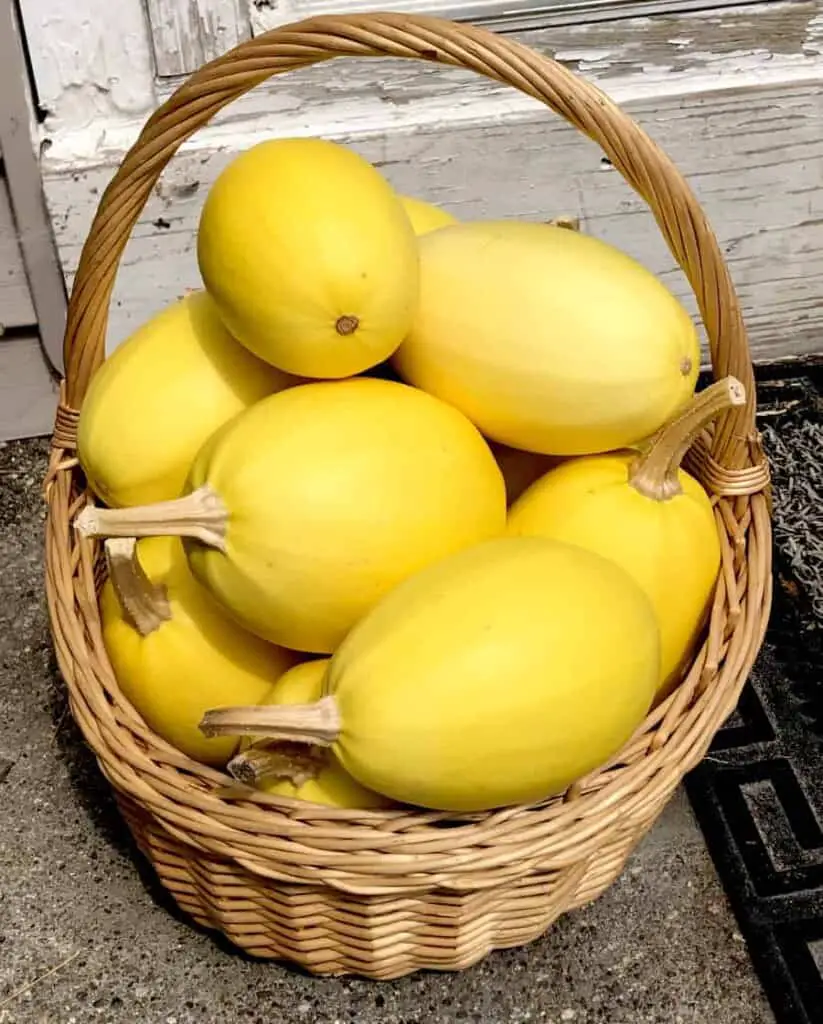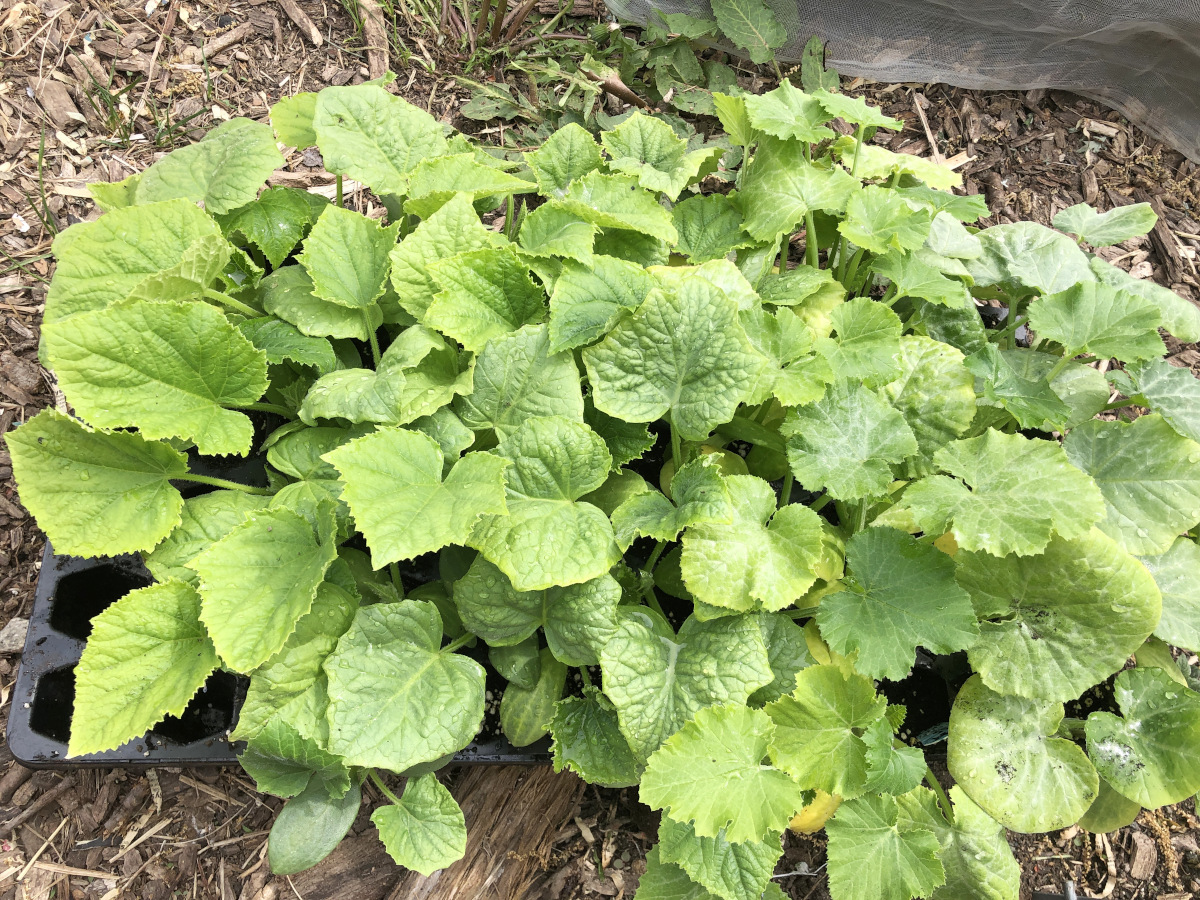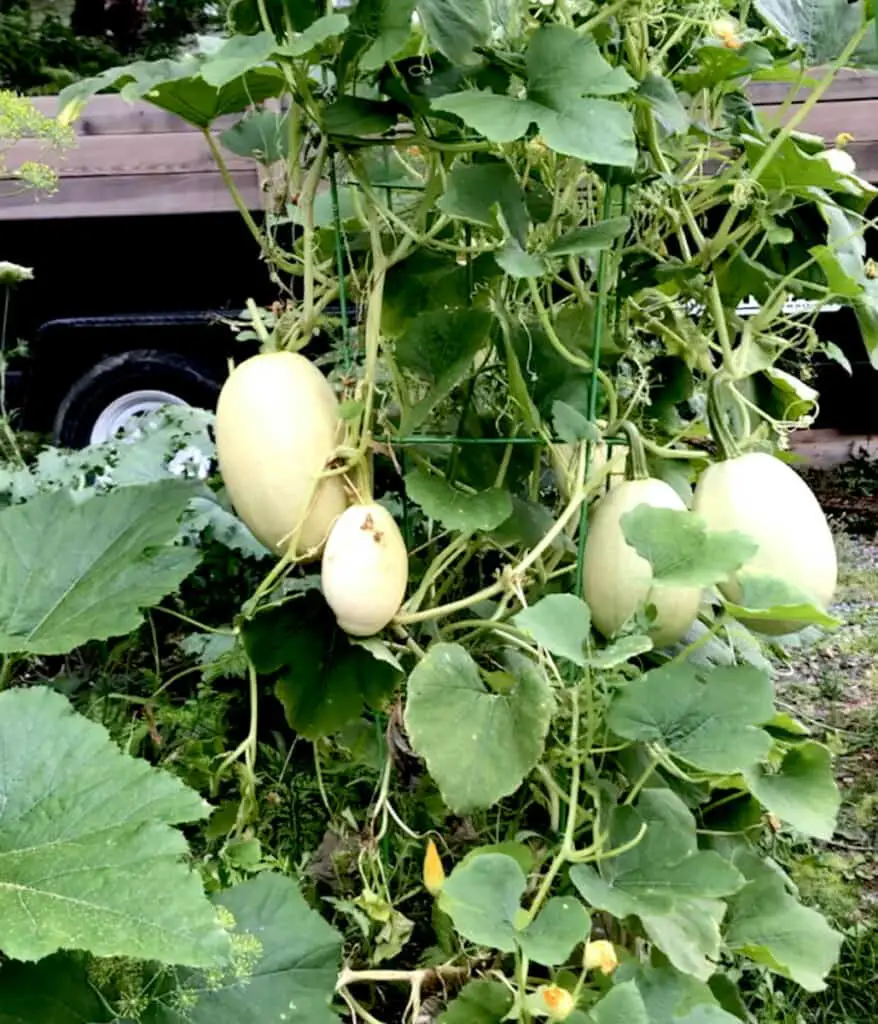- Spaghetti squash can be started from seed indoors about 2 weeks before the last frost date. After hardening of the seedlings, they can be transplanted outdoors after the last frost date, when the soil warmed up to about 60F.
- It also does well direct seeded after the last frost date, when the soil reached about 60F. Protect sowed seeds from rodents and birds who like to dig it out and eat it, by covering them.
- Plant 1-2 seeds in a hole about ½ to 1 inch deep. Cover with soil, tamp the surface gently, and water thoroughly. Start seeds indoors under grow lights or on the south-facing windows for the most prolonged and brightest sun exposure. Use a humidity dome to sprout seeds faster.
- Water seedlings every day and never let the soil dry out completely as this could kill sprouting seeds or prolong the germination process. Keep the soil moist, but not soggy.
- Once the spaghetti squash has 2 sets of true leaves and the root system is extensive, it is really to be transplanted outdoors. Always harden off the seedlings before transplanting them.
- Spaghetti squash likes loamy, fertile soil full of organic matter, that drains well. Soil can be amended with organic matter like compost, worm castings, or well-aged animal manure.
- Choose a sunny location as spaghetti squash is a warm-weather crop and likes at least 6 hours of full sun.
- Support the spaghetti squash plant with a tomato cage if you wish to grow it vertically. Wrap the vining plant around the cage as it grows.
- Fertilize and water the plant regularly. Water with 1-2 inches of water a week. Fertilize following the instructions on the packaging of the fertilizer of your choice.
- Ensure female flowers are well pollinated for best production. Hand pollinates if needed.
- Harvest once the fruit is mature, reached uniform full size, yellow color, and the stem the fruit is attached to the plant is dry. When harvesting, leave about 1 inch of the stem on each fruit.
- Cure spaghetti squash fruit in the sun for about 7-10 days to harden off the skin. Curing spaghetti squash means hardening the skin and healing any cuts and bruises to prepare the squash for winter storage.
- During the growing process inspect the spaghetti squash plant and set fruit for pests. The most common pests attracted to spaghetti squash are vine borers, squash bugs, and cucumber beetles. Eliminate the pests by collecting them by hand, or spray with soapy water by mixing 6-7 tablespoons of dish soap with 1 gallon of water. Spray the bugs down with this mixture and repeat as needed.

A GOOD READ: How to start seeds and care for seedlings
What month do you plant spaghetti squash?
Spaghetti squash can be planted from mid-March indoors to early June, depending on the hardiness zone in which you grow. Once temperatures reached 60F it can be directly sowed outdoors after the danger of the last frost date has passed.
I sow my spaghetti squash seeds indoors about 3 weeks before the last frost, at the beginning of May. My last frost date is May 16, therefore I plant about 3 weeks before the date as spaghetti squash grows fast. Then I harden the seedlings off once the danger of frost is over and plant them when eh weather warmed up. By then, my seedlings have 2 sets of true leaves and a very well-established root system.
How to prevent seeds from being eaten
Does spaghetti squash grow back every year?
No, spaghetti squash is an annual vegetable which means it grows only for one life cycle and then dies off and it does not come back every year. A new plant has to be grown from the seed again.

How do you grow bigger spaghetti squash?
To grow bigger spaghetti squash, plant it in a sunny location with at least 6 hours of full sun. Ensure the soil is fertile and water and fertilize it as needed. Keep the soil moist and mulch around the plant to preserve water in the soil. Allow enough space for the plant about 1 square foot per plant in order to grow larger fruit.
How and when to water vegetable garden
I grow 3 plants per 1 tomato cage, so I usually get the first fruit larger and the following fruit after that are smaller. Which I do not mind, as I still get the fruit of a nice size for our family size. I would rather get a large number of smaller fruit than a couple of large ones.
As I have a small growing lot, therefore I space my plants providing them with space enough to grow and mature but as close as I can for the most efficient of my limited growing space.
This year, I use this liquid fertilizer. I use it for my whole garden including spaghetti squash. I dilute it 10 mills per 1 gallon of water using a small medicine cup with measurements to measure out 10 mills. One could make the fertilizer stronger o gentler by mixing. So far, my garden looks very nice and we just can’t keep up with our salad harvest. My broccoli looks great. And spaghetti squash? I do not worry about it at all as it delivers a nice harvest every year!
Should you prune spaghetti squash plants?
I do not prune my spaghetti squash plants as the plant knows what to do, and I want the maximum production from each plant.
When to harvest spaghetti squash?
Harvest spaghetti squash fruit once it has reached mature usable size, the skin is dark yellow color and the stem with which the fruit is attached to the vine is dry. Leave at least 1 inch of the stem attached to the fruit. Cure spaghetti squash after harvest before storing it.
How to cure spaghetti squash?
Cure spaghetti squash fruit after harvest in a sunny, dry spot for about 7-10 days. Rotate the fruit as it dries a few times. Once the skin has hardened and the fruit has reached rich deep yellow color the fruit is ready to be stored in a dark, cool, dry place for winter.
I store my spaghetti squash fruit in a dry, dark basement, in cartons on a shelf. Check them periodically, as sometimes they can decompose and dry from the inside out.
Does spaghetti squash need to climb?
Spaghetti squash is a vining plant meaning it grows long stems that can climb if trained.

I have my spaghetti squash growing on tomato cages because my garden has limited growing space so to save space and even plant underneath the spaghetti squash I simply train my squash to grow vertically wrapping it around the tomato cage. It is very easy for me to then see the fruit developing, hand pollinate, and protect the plant and the fruit as well as harvest.
TIP: I place my spaghetti squash fruit in a knee-high stocking to protect it from pests. I simply dress my spaghetti squash fruit in the stockings once the flower falls off and leave it on until the harvest. This method helps me to protect any insect burying its eggs in the fruit, eating it, or creating any holes. It also protects my fruit from ground pests like snails and slugs, when grown on the ground.

In my growing space, spaghetti squash grows like weeds and it is my go-to pantry stocking vegetable because of how easy it is to grow and store it. It requires no babysitting, very little attention, and almost thrives on neglect.
As I cook with it and throw the inside of the squash in the compost pile it reseeds itself, I get many volunteer plants in my garden beds and in a compost pile. I just collect new sprouts from my yard and plant them or sell them!
I wholeheartedly recommend spaghetti squash for beginners.
TIP: You do not have to buy spaghetti squash seeds. I planted mine from store-bought organic squash. I plant, save the seeds and repeat every year since then. Free seeds that came with the food itself! I did the same with my butternut squash.
How to save seeds from spaghetti squash
Let the spaghetti squash fruit ripe well on the vine, until the fruit is large, the skin tough to pierce with the fingernails, and the stem of the fruit dries out. Then harvest the fruit and cure it in the sun for 7-10 days. Once you are ready to cook the squash, take the seeds out and rinse them. Let them stay in clean water to ferment at room temperature for 2 days. Rinse clean and let them dry on the parchment paper for a couple of days. Once the seeds are dry, store them in a dry, cool, and dark place in an airtight container.
TIP: You can plant fresh seeds too. If it is spring and you get a nice mature fruit from the store, simply take out the largest, fattest seeds and plant them. They should sprout and grow with no problem.
When and how to grow zucchini, summer squash

